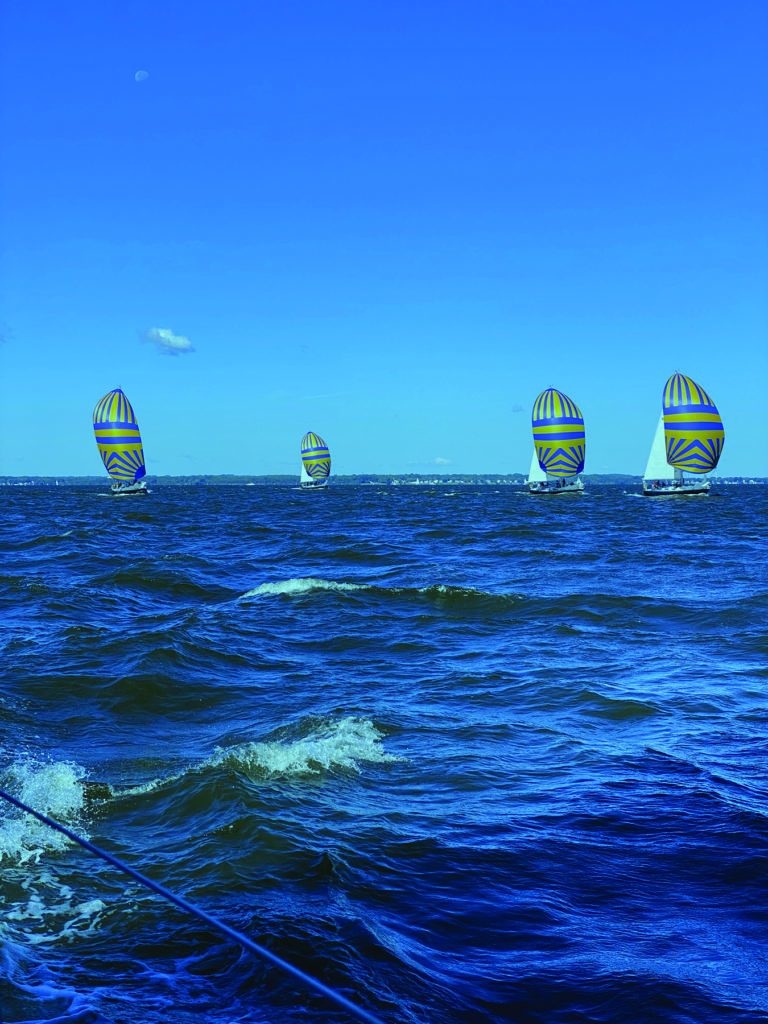
Every other summer, US Sailing puts on the U.S. Offshore Sailing Championship, an invitational regatta with all the bells and whistles provided by the US Naval Academy in Annapolis, Maryland. Open to any US Sailing member in the country, skippers apply to US Sailing detailing their team, past events, and regattas as a group. Basic requirements are that at least five of the seven crew have sailed together in a minimum number of events over the past year.
This year’s regatta saw eight teams registered from all corners of the country, to name a few: Rhode Island, San Diego, Florida, and excitedly, our own team from Seattle. In addition to the traveling competitors, the Naval academy offshore team fielded a boat of their varsity midshipmen, by far the favorites going into the weekend. After a year of minimal travel outside of our home waters, it was a fantastic chance to make new friends and catch up on what has been going on around the country.
Our team this year was comprised of many regulars from races aboard our Northwest-based boat Smoke: Lucy Joel, Kaitlin Amedio, Josh May, Christina Travis, Bryan Rhodes, and myself, plus Steve Travis at the helm. Our midshipman for the weekend was first classman Keegan Steele, an offshore racing team member and skipper on the Navy Farr 40’s. While our team was full of seasoned racers with a wealth of experience on some fast boats, our equipment for the weekend was somewhat less than what anyone would consider fast. The Navy 44’s were built to take groups of first and second year midshipmen offshore for extended training trips, and are built like tanks. Heavy, sturdy, and nearly impossible to get moving in light air, and equally difficult to stop on heavy air, these boats present their own challenge to shepherd around the racecourse. Thankfully, the event is a one design format, with crews switching vessels each day, taking their sails with them from boat to boat, making as even of a playing field as practical for all the racing teams.
The first day of the event brought with it light wind from an unfamiliar northwesterly direction as a frontal system had passed the day before. Heavy rain overnight led to some shroud current swirls at the mouth of the harbor, and it was simply a game of keeping the boats moving and not getting left behind. Racing got underway after a couple of postponements and major shifts forced the committee to call off the start. Quick thirty-minute short course buoy racing was in store for the early part of the day and it was an impressive level of intensity right out of the gate as teams came into the line fast and jockeyed for position on the favored end.
There was one incident of a collision, but thankfully, the only significant damage was a bent lifeline stanchion and a bruised bow. The sound of an immovable object meeting an unstoppable force certainly woke up the entire fleet. The day wrapped up with a longer coastal style distance race that took us on a tour of the Chesapeake Bay in dying breeze and swirling currents. Being from Seattle, we felt right at home and pulled off a solid third in the race and with distance races worth more in the overall score than the short courses, we ended up in a solid third place for the day with the Naval Academy Team leading the fleet.
On the second day of racing, the post-frontal conditions won out, and after several hours of sitting and waiting, it was decided that our time was better spent exploring the historic town of Annapolis. Having some time to walk the Academy’s campus and enjoy the town was amazing, and the amount of sailing history always blows us Western kids away. Finally wrapping up the day with sunset drinks at the Annapolis Yacht Club with our loaner midshipman “Keegs” in tow was certainly a highlight of the trip.
The final day of racing brought with it some breeze, quite a lot of breeze to be precise. Seeing high teens and touching into the twenties as we motored out onto the racecourse made for some complicated tactical calls in the prestart as we sorted out how best to sail the boats in the dramatically different conditions.
Things got underway on time with a pair of distance races sending us to some familiar marks and a couple new ones as the day progressed. The wind continued to build throughout the first race, but suddenly we found ourselves in a breakaway with the Naval Academy team and took second place back in the second group. Wrapping up the race just boat lengths from first, we were happy with our performance and clean sailing in the heavy winds. Coming into the final race, we had a clean start and found ourselves in the lead pack at the first mark, following a sporty and neck-and-neck spinnaker run, we came into the leeward mark in a three-way tie with our closest competition, and thanks to amazing crew work at the rounding, came out literally on top. From there, it was just a game of staying between our competition and the finish, which got stressful in moments headed to the finish in the shifty high winds.
At the end of the day, we found ourselves on the top of the list, and with smiles abound, we cleaned up the boat, took a quick team photo, and piled into the cars to get to the airport to catch our flight back to Seattle! An absolutely whirlwind of a weekend, and easily one of the highlights of my sailing career thus far. If tight competition in an amazing venue with fantastic people sounds like fun, be sure to get your application ready for the next U.S. Offshore Sailing Championship— you will not be disappointed.